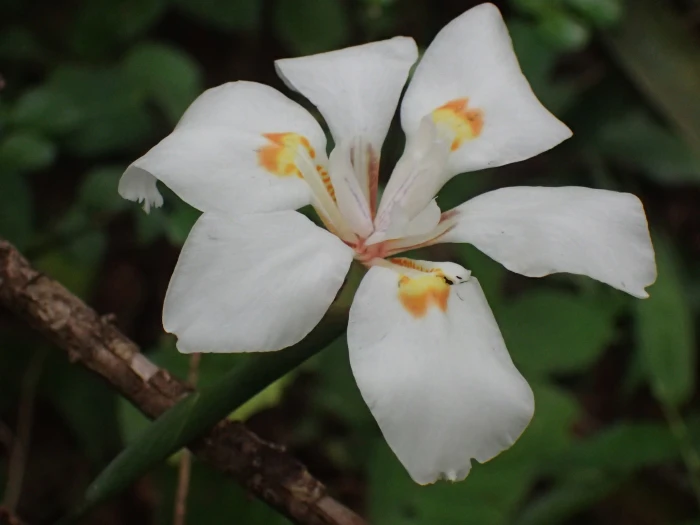Forest Wild Iris
(Dietes butcheriana)
Forest Wild Iris (Dietes butcheriana)
/
/

Mahomed Desai
CC BY 4.0
Image By:
Mahomed Desai
Recorded By:
Copyright:
CC BY 4.0
Copyright Notice:
Photo by: Mahomed Desai | License Type: CC BY 4.0 | License URL: http://creativecommons.org/licenses/by/4.0/ | Rights Holder: Mahomed Desai | Publisher: iNaturalist | Date Created: 2021-01-10T10:03:20-08:00 |









Estimated Native Range
Climate Requirements for Socastee, South Carolina
| This Plant | Your Site | Plant Suitability for Your Location | ||
|---|---|---|---|---|
| • Precipitation | 38" - 46" | 53" | Aquatic | Aquatic |
| • High Temp. | 76°F - 84°F | 90°F | Your summers may be too hot for this plant. | Too hot |
| • Low Temp. | 40°F - 52°F | 36°F | Your winter temperatures may be too cold for this plant | Too cold |
This plant may not grow well at your location - your precipitation is too high.
Summary
Dietes butcheriana, commonly known as Forest Wild Iris, is a deciduous perennial herb native to the forest margins and grassy slopes of the Eastern Cape to KwaZulu-Natal in South Africa. It typically reaches a height of 3-4 feet (0.9-1.2 meters) and a width of 2-3 feet (0.6-0.9 meters). The plant forms clumps of long, arching, sword-like leaves and is known for its striking white flowers with yellow and violet markings, which bloom in the spring and summer and are quite showy. The blooms resemble those of irises, hence the common name.
The Forest Wild Iris is valued for its attractive foliage and flowers, which add a tropical flair to gardens. It is often used in mass plantings, as an accent in borders, or in containers. While it prefers part shade, it can also tolerate full sun if provided with enough moisture. It requires well-drained soil and can handle occasional dry spells once established. Regular deadheading of spent flowers can encourage more blooms. It is generally pest and disease-free but can be affected by snails and slugs. This species is not known for being invasive and is a low-maintenance option for gardeners seeking a lush, grass-like appearance with the added benefit of flowers.CC BY-SA 4.0
The Forest Wild Iris is valued for its attractive foliage and flowers, which add a tropical flair to gardens. It is often used in mass plantings, as an accent in borders, or in containers. While it prefers part shade, it can also tolerate full sun if provided with enough moisture. It requires well-drained soil and can handle occasional dry spells once established. Regular deadheading of spent flowers can encourage more blooms. It is generally pest and disease-free but can be affected by snails and slugs. This species is not known for being invasive and is a low-maintenance option for gardeners seeking a lush, grass-like appearance with the added benefit of flowers.CC BY-SA 4.0
Plant Description
- Plant Type: Herb
- Height: 2.5-4 feet
- Width: 1.5-3 feet
- Growth Rate: Moderate
- Flower Color: White
- Flowering Season: Spring, Summer
- Leaf Retention: Deciduous
Growth Requirements
- Sun: Full Shade, Part Shade
- Water: Medium
- Drainage: Medium
Common Uses
Bee Garden, Butterfly Garden, Groundcover, Low Maintenance, Showy Flowers
Natural Habitat
Native to forest margins and grassy slopes of the Eastern Cape to KwaZulu-Natal in South Africa
Other Names
Common Names: Forest Iris, Broad-Leaved Dietes, Bosiris, Isiyunga, Iconya
Scientific Names: Dietes butcheriana
GBIF Accepted Name: Dietes butcheriana Gerstner